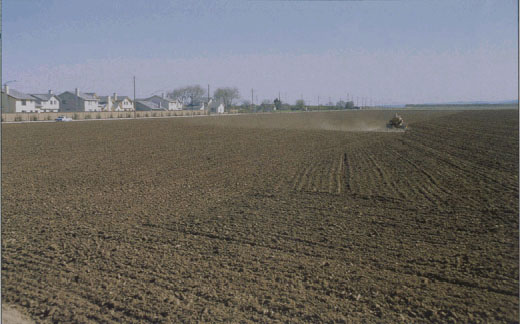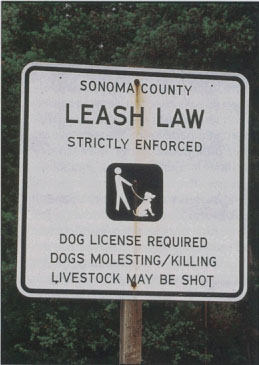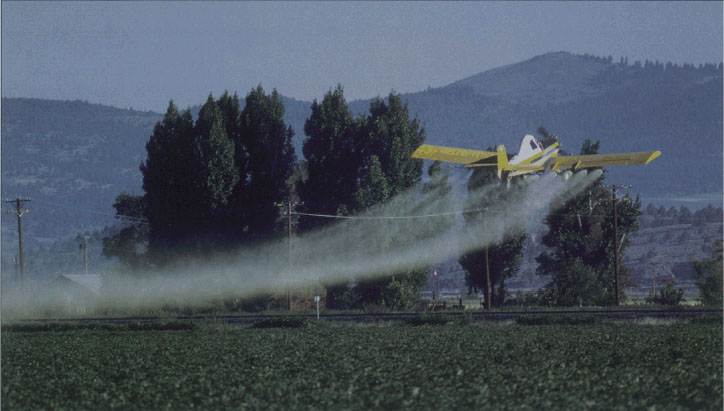All Issues
Conflicts arise on the urban fringe
Publication Information
California Agriculture 52(3):11-16. https://doi.org/10.3733/ca.v052n03p11
Published May 01, 1998
PDF | Citation | Permissions
Abstract
The frequent expansion of urban edges presents a challenge for California agriculture as the state's rich farmland base is consumed by nonfarm development. Some issues of conflict emerge as a part of the struggle for limited resources while others are related to the proximity of urban development and agriculture. Other conflicts reflect the urban resident's and farmer's different perspectives on the purpose or value of farmland. Local governments need to establish firm urban-growth boundaries, create buffers between agriculture and urban land uses, and zone to eliminate incompatible land uses in agricultural areas. For its part, the agricultural community needs to educate the urban public to help them understand why particular farm management practices are necessary.
Full text
As cities expand, urban residents are coming into closer contact with agriculture, as shown here near Modesto.
The conflict between urban and agricultural land uses is intensified by the frequent expansion of urban edges into farmland. These unstable urban edges cause problems because urban residents and farmers have different perspectives on the purpose or value of farmland. Approaches to reducing this conflict include establishing firm urban-growth boundaries and better buffers to separate urban and agricultural land uses, eliminating incompatible uses in agricultural zones, and increasing the nonfarm public's understanding of farm management practices. These findings are from a study of urban/agricultural conflict and specific approaches that local governments have taken to reduce or eliminate the conflict in 16 California counties and several cities therein (Handel 1994).
California is the nation's leading agricultural producer and most populous state at 33.2 million and growing. Adding more than half a million people to the state each year increases the pressure daily for urban development on and adjacent to farmland.
Intruding urban residents have created new problems for farmers. Above, vandals caused over $80,000 in damage to three new cotton planters at a farm in Fresno County. The resultant delay in planting also cost this Riverdale grower $150,000 in yield losses.
Expanding city edges are a hot spot for urban/agricultural conflict because many of California's cities are surrounded by farmland and few have firm urban-growth boundaries. These unstable urban edges create an atmosphere of impermanence for California farmers: those not directly adjacent to cities today may find themselves there tomorrow. When farmers near the edge begin waiting for their time to sell out, they no longer have an incentive to invest in new farm equipment or long-term crops, or to adopt long-term production management techniques.
The edges of unincorporated communities are also hot spots for urban/agricultural conflict. The pressure to create commercial centers in unincorporated areas continues to increase as counties seek ways to generate more revenues in the post-Proposition 13 era, which cut property tax yields for local governments.
The third hot spot for urban/agricultural conflict is incompatible uses on land zoned for agriculture. The general plans of most agricultural counties allow nonagricultural uses on farmland including golf courses, recreational facilities, bed-and-breakfast inns, churches, schools and daycare centers. Besides creating conflicts with adjacent farmers, such incompatible uses can create new centers of development, making them an even greater threat to agriculture than the expansion of cities and unincorporated communities.
When urban development meets farmland, both urban residents and farmers suffer inconveniences. However, the fact that farmers suffer inconveniences is often forgotten by city planners, who give priority to the immediate comfort of the urban resident.
The urban perspective
Urban edge residents commonly complain about agricultural pesticide use. Neighbors adjacent to farmland fear that the pesticides used in agriculture put them at risk for chronic health problems. They do not trust the farmer's judgment regarding pesticide use and usually do not know what chemical is being applied or for what reasons.
Urban edge residents also commonly complain about agricultural noise. Most people think of the countryside as a peaceful alternative to loud cities. Their expectations are shattered when the neighboring farmer destroys the peace and quiet of the country, for example, by machine harvesting at night. Urban residents are particularly disturbed when farmers use aircraft because besides being noisy, air applications heighten concerns over chemical use.
Likewise, odors do not meet urban residents' expectations of rural living. Neighbors complain about odors from plant decay and dairy, poultry or other livestock operations. Livestock operations often also generate complaints about flies.
Urban residents also complain about the dust generated by disking, mowing or harvesting. Dust is an intrusion on their quality of life and in many cases may threaten their health. Similarly, agricultural burning can destroy an otherwise clear day.
As subdivisions spring up around farmland, growers are forced to change their practices, such as curtailing aerial pesticide sprays.
Finally, urban residents complain about slow farm equipment that blocks the flow of traffic. To many urban residents, the least the farmer could do is use the roadway only during noncommute hours
The farm perspective
Growers often resent the sudden intrusion of urban residents who create the need for special management practices that may result in loss of crop productivity and add time, cost and labor. For example, pesticides that were used in the past may be prohibited and application by aircraft may be eliminated. Farmers also resent noise and odor complaints. They wonder why urban residents move to an agricultural area if they don't like the noises and odors associated with farming.
While urban residents complain about domestic flies, midges, mosquitoes and other pests from farmlands, farmers complain about pests from urban areas. For example, when subdivisions replace an orchard, any token trees left to justify the subdivision's name can provide a haven for pests. In addition, packs of dogs from neighboring subdivisions sometimes harass cattle or sheep.
While urban residents are impatient with slow farm machinery on roads, the increased traffic that accompanies urban expansion also causes problems for farmers. Trying to merge large equipment onto a busy roadway can be difficult and dangerous.
A chief concern of landowners is increased trespassing and the corresponding increased liability. As more people move into rural areas, or chards, grazing lands and reservoirs become enticing recreation lands.
According to a Kern County grower, “I used to let people picnic on my property. Families from Los Angeles County would drive here to spend an afternoon in the country, until one visitor broke his arm and sued me for $10,000. Now I have to chase people off my property because the liability is too great. Today a farmer could lose everything in one lawsuit.”
An increase in urban residents also brings an increase in theft, vandalism and litter on farms. Most farm equipment is not under lock and key, and any equipment left in the field at the end of a day's work becomes a target for theft and vandalism. In livestock country fences may be cut and gates left open, allowing cattle or sheep to escape. Fencing to deter trespassers is costly and makes it difficult to maneuver equipment and move crops out of fields (California Department of Conservation 1991).
Influences on the conflict
A crop's layout influences both the level of inconvenience to nearby residents and the grower's ability to adapt to farming restrictions caused by urban encroachment. For example, while the best direction for planting crop rows is likely to depend on sun exposure and drainage, raising crops in rows that parallel the urban edge will be more convenient if the agricultural commissioner decides that the rows near the edge should not be sprayed. Then only the few rows near the edge will need special treatment, perhaps by hand. But if the rows ran perpendicular to the edge, the grower will be required to drive the tractor and spray rig down each row and turn off the spray machine before reaching each end. This wastes time and fuel running the tractor where the spray rig can't be engaged.
California's rapid conversion of farmland to houses usually brings an urban population that is generations removed from the farm. These new residents do not understand California agriculture and their attitudes about farming do not include tolerance of the inconveniences that come from normal farm practices.
As one agricultural commissioner noted. “They see blossoms and fields of mustard in the early spring and assume that this is what rural living is all about, but as summer approaches after they've moved into their new homes, the noise, dust and smells drive them crazy.”
But urban attitudes toward farm operations are not always negative. Three cities in this study — Delano, Woodland and Petaluma — show that the rate and pattern of growth within cities influence the urban attitude toward adjacent farmland. For example, the Woodland Edges Project found that many of the residents of this Yolo County city have lived there a long time (43% had lived there for more than 25 years), and they generally expect that there will be some nuisances in a farming community.
Similarly, a city official from Petaluma in Sonoma County reported that few citizens there complain about agricultural practices because most people realize they live in a farm community. “Agriculture is an important part of the economy here,” he said. One of the reasons so many residents understand the city's tie to agriculture may be that growth has been limited since the early 1970s, when Petaluma became the first community in the nation to establish an urban limit line and limit the number of permits for development projects.
Cities like Petaluma are the exception, however. Most local governments lack urban growth boundaries to stabilize the edge between urban and agricultural areas. They lack policies to restrict nonfarm uses from invading California's agricultural areas. Reducing the urban/agricultural conflict will require that local governments and perhaps the state government become more involved with growth management issues.
The bucolic scenery may draw people to rural areas, but they are not always enamored with the sounds and smells associated with livestock.
The value of farmland
Another major cause of the urban/agricultural conflict comes from the different viewpoints on the purpose or value of farmland. City and county decision-makers often view farmland as a provider of open space or as a land bank for future urban expansion. Urban residents often view farmland as a place for idyllic country living. To the farmer, however, farmland provides the means for making a living.
Several city and county general plans promote agricultural land as an open-space buffer between one community and another, between residential and industrial uses, and between airports and residential uses. Logan and Molotch note that California has some of the most productive farmland in the world, but when urbanization threatens that farmland, the public is concerned about losing open space rather than productivity (Logan and Molotch 1987).
Because open space is so desirable, houses on the edge next to agriculture are often more expensive than houses surrounded by more houses. Ironically, the urban edge's high property value may make the residents there more sensitive to inconveniences caused by agriculture. Edge residents accepted the high home price in exchange for peaceful rural living, but the adjacent farmer erodes the value of the investment with noise, smells and pesticides. The risk of losing an investment may explain why edge neighbors will fight the farmer with a lawsuit if necessary.
Farmland is also viewed by some cities and counties as a convenient way to hold land until the time for urban development. Most city planners recognize the convenience of keeping land in large parcels (agricultural parcels are usually 40 acres or more) at the city's edge so the land can some day be developed without existing structures blocking logical, street, sewer and water extensions.
Farmers have been fighting the open space notion for some time. To the farmer, agricultural land is a resource for producing goods to sell. If a farmer can't make a reasonable living from this working landscape, it may be converted to other uses including more urban development.
The general plans of most agricultural counties allow nonagricultural uses on farmland, such as this driving range north of Stockton; such uses can create conflicts with adjacent farmers.
As several authors warn, “[t]here is no such thing as farmland without farmers. It nonfarmers are to enjoy the amenities of a working rural landscape, then they must either learn to tolerate farming practices or else settle at a distance from farm operations. The friction between farmers and nonfarmers involves a clash of property rights that cannot be resolved in the marketplace. Instead, legislative bodies and the courts must act as referees” (Lapping et al. 1989).
While farmers have helped change some general plans to recognize agriculture as an industry instead of simply open space, the concept of separating residential development from the industry of agriculture is only beginning to be recognized by some local governments as a legitimate concern.
Reducing the conflict
The decisions of appointed and elected local officials often reflect the nonfarm values prevalent in the general public because only 2 of California's population is directly involved in food and fiber production. However, viewing agriculture as an industry would make it easier for local planners and decision-makers to advocate land-use decisions and other measures that will help reduce the urban/agricultural conflict.
Local governments need to establish firm urban growth boundaries. Every time the urban edge moves, new farmers are suddenly faced with the same problems of farming next to the edge. Their frustration eventually leads to a desire to sell out to development and the cycle continues. Conversely, firm urban growth boundaries clearly distinguish land for urban development from land for agriculture. It helps remove expectations of buying “cheap” farmland for urban development. Conservation easements are a useful tool to help compensate the farmers at the edge.
Local governments also need to establish appropriate buffers between agriculture and urban land uses, and to clean up their general plans and zoning ordinances to eliminate incompatible land uses in agricultural areas. For example, because local governments allow houses on agricultural parcels, the potential for conflict is much greater when smaller agricultural parcels are created.
For its part, the agricultural community needs to make friends with the urban public to help them understand why particular farm management practices are necessary. Why, for example, do wind machines need to operate at 3 o'clock in the morning? Why do growers have to harvest at night? Why does rice need to be seeded with an airplane? Education efforts can help urban populations understand the industrial nature of farmland so their expectations of living in the country aren't contrary to reality.
Several farm organizations already dedicate time and money to this task, and some farmers are developing their own education programs by holding tours and field days at their farms and ranches. A few farm operators provide information to urban neighbors by walking the neighborhoods to inform residents of various management practices associated with their particular agricultural operations.
Reducing the urban/agricultural conflict will help us meet the challenge of maintaining our world-class agriculture in a state with a population growing faster than many Third World countries.










